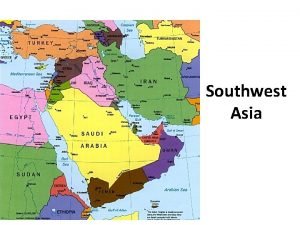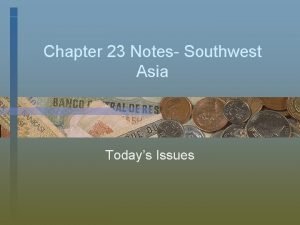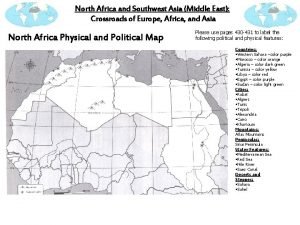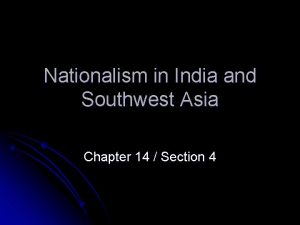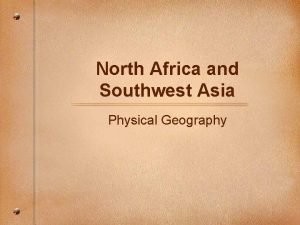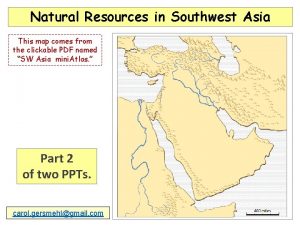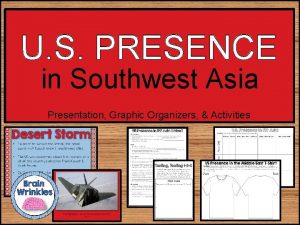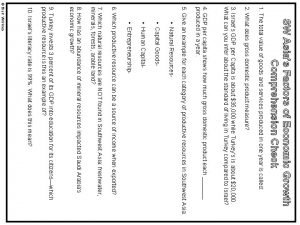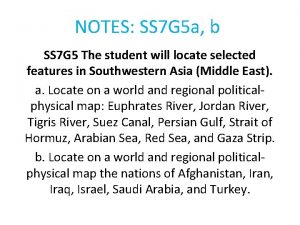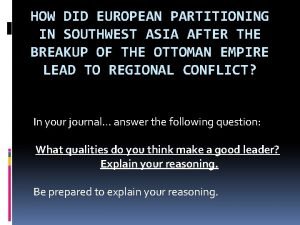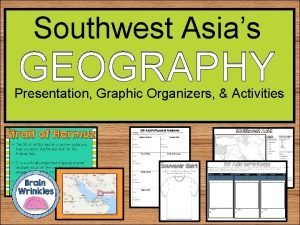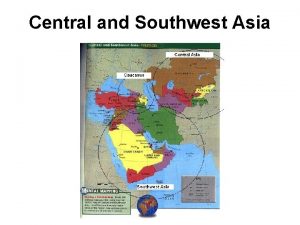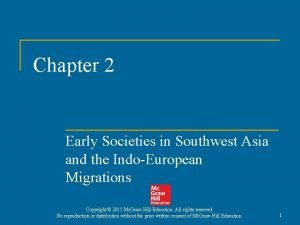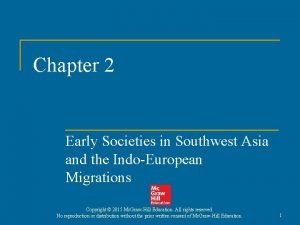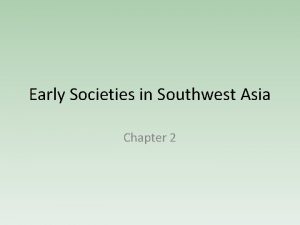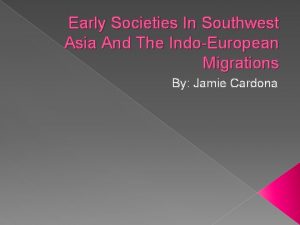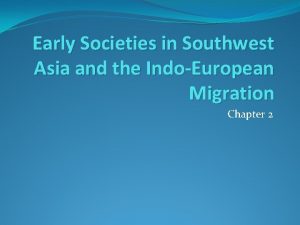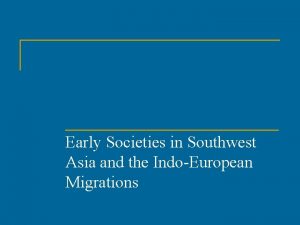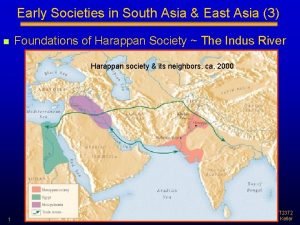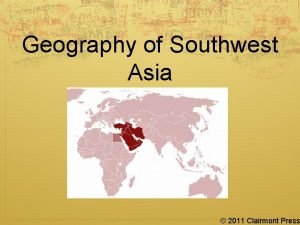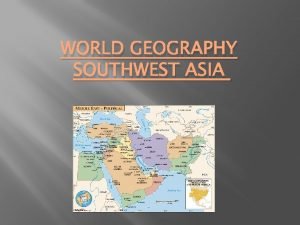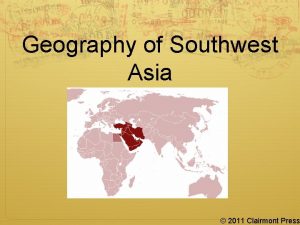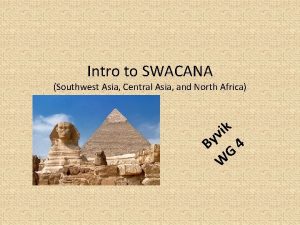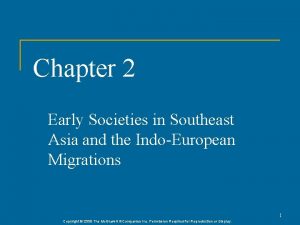Chapter 2 Early Societies in Southwest Asia and



























- Slides: 27

Chapter 2 Early Societies in Southwest Asia and the Indo-European Migrations © 2011, The Mc. Graw-Hill Companies, Inc. All Rights Reserved. 1

Civilization Defined n n n n Urban Political/military system Social stratification Economic specialization Religion Communications “Higher culture” © 2011, The Mc. Graw-Hill Companies, Inc. All Rights Reserved. 2

Mesopotamia n n “Between the Rivers” q Tigris and Euphrates Modern-day Iraq Cultural continuum of “fertile crescent” Sumerians the dominant people 3

The Wealth of the Rivers n n Nutrient-rich silt Key: irrigation q q q n n Sumer begins small-scale irrigation 6000 B. C. E. By 5000 B. C. E. , complex irrigation networks q n Necessity of coordinated efforts Promoted development of local governments City-states Population reaches 100, 000 by 3000 B. C. E. Attracts Semitic migrants, influences culture © 2011, The Mc. Graw-Hill Companies, Inc. All Rights Reserved. 4

Sumerian City-States n n n Cities appear 4000 B. C. E. Dominate region from 3200 to 2350 B. C. E. Ziggurat home of the god q n n n Uruk Irrigation systems Defense from nomadic marauders Absolute monarchies © 2011, The Mc. Graw-Hill Companies, Inc. All Rights Reserved. 5

The Ziggurat of Ur © 2011, The Mc. Graw-Hill Companies, Inc. All Rights Reserved. 6

Political Decline of Sumer n Semitic peoples from northern Mesopotamia overshadow Sumer q Sargon of Akkad (2370 -2315 B. C. E. ) n n n Hammurabi of Babylon (1792 -1750 B. C. E. ) q q n Destroyed Sumerian city-states one by one, created empire based in Akkad Empire unable to endure chronic rebellions Improved taxation, legislation Used local governors to maintain control of city-states Babylonian empire later destroyed by Hittites from Anatolia, ca. 1595 B. C. E. © 2011, The Mc. Graw-Hill Companies, Inc. All Rights Reserved. 7

Legal System n n Code of Hammurabi Established high standards of behavior and stern punishment for violators q q Lex talionis – “law of retaliation” Social status and punishment 8

Later Mesopotamian Empires n n Weakening of central rule an invitation to foreign invaders Assyrians use new iron weaponry q n Beginning 1300 B. C. E. , by eighth to seventh centuries B. C. E. control Mesopotamia, Syria, Palestine, most of Egypt Nebuchadnezzar of Babylon (r. 605 -562) takes advantage of internal dissent to create Chaldean (New Babylonian) empire q Famously luxurious capital © 2011, The Mc. Graw-Hill Companies, Inc. All Rights Reserved. 9

“Hanging Gardens of Babylon” & “Tower of Babel” 10

Mesopotamian Empires, 1800 -600 B. C. E. © 2011, The Mc. Graw-Hill Companies, Inc. All Rights Reserved. 11

Technological Development in Mesopotamia n Bronze (copper with tin), ca. 4000 B. C. E. q n Iron, ca. 1000 B. C. E. q n n Military, agricultural applications Cheaper than bronze Wheel, boats, ca. 3500 B. C. E. Shipbuilding increases trade networks © 2011, The Mc. Graw-Hill Companies, Inc. All Rights Reserved. 12

Social Classes n Ruling classes based often on military prowess q n Religious classes q q n Role: intervention with gods to ensure good fortune for community Considerable landholdings, other economic activities Free commoners q q n Perceived as offspring of gods Peasant cultivators Some urban professionals Slaves q Prisoners of war, convicted criminals, debtors © 2011, The Mc. Graw-Hill Companies, Inc. All Rights Reserved. 13

Patriarchal Society n n Men as landowners, relationship to status Patriarchy: “rule of the father” q n Double standard of sexual morality q q n Women drowned for adultery Relaxed sexual mores for men Yet some possibilities of social mobility for women q n Right to sell wives, children Court advisers, temple priestesses, economic activity Introduction of the veil at least ca. 1500 B. C. E. – predates Islam 14

Development of Writing n n n Sumerians experiment with pictographs 2900 B. C. E. Sumerians create writing system Cuneiform: “wedge-shaped” q q Preservation of documents on clay Declines from 400 B. C. E. with spread of Greek alphabetic script © 2011, The Mc. Graw-Hill Companies, Inc. All Rights Reserved. 15

Uses for Writing n n n Trade Astronomy Mathematics q n Agricultural applications Calculation of time q q q 12 -month year 24 -hour day, 60 -minute hour 360 degree circle © 2011, The Mc. Graw-Hill Companies, Inc. All Rights Reserved. 16

Mesopotamian Literature n n Epic of Gilgamesh, compiled after 2000 B. C. E. Heroic saga Search for meaning, especially the afterlife This-worldly emphasis 17

The Early Hebrews n n n According to Hebrew scripture, Abraham migrated to northern Mesopotamia ca. 1850 B. C. E. Parallels between early biblical texts, code of Hammurabi Scriptures state Hebrews under Moses go to Palestine, ca. 1300 B. C. E. q n On-going conflict with indigenous populations King David (1000 -970 B. C. E. ) and Solomon (970 -930 B. C. E. ) © 2011, The Mc. Graw-Hill Companies, Inc. All Rights Reserved. 18

Moses and Monotheism n n Hebrews shared polytheistic beliefs of other Mesopotamian civilizations Moses introduced monotheism, belief in single god q q q Denied existence of competing parallel deities Personal god: reward and punishment for conformity with revealed law The Torah (“doctrine or teaching”) © 2011, The Mc. Graw-Hill Companies, Inc. All Rights Reserved. 19

Foreign Conquests of Israel n Assyrian conquest, 722 B. C. E. q q q n Conquered the northern kingdom Deported many inhabitants to other regions Many exiles assimilated and lost their identity Babylonian conquest, 586 B. C. E. q q q Destroyed Jerusalem Forced many into exile Israelites maintained their religious identity and many returned to Judea © 2011, The Mc. Graw-Hill Companies, Inc. All Rights Reserved. 20

Israel and Phoenicia, 1500 -600 B. C. E. © 2011, The Mc. Graw-Hill Companies, Inc. All Rights Reserved. 21

The Phoenicians n n City-states along Mediterranean coast after 3000 B. C. E. Extensive maritime trade q n Dominated Mediterranean trade, 1200 -800 B. C. E. Development of alphabet symbols q q Simpler alternative to cuneiform Spread of literacy © 2011, The Mc. Graw-Hill Companies, Inc. All Rights Reserved. 22

23

Indo-European Migrations n n Common roots of many languages of Europe, southwest Asia, India Implies influence of a single Indo-European people q n Probable original homeland: modern-day Ukraine and Russia, 4500 -2500 B. C. E. Domestication of horses, use of Sumerian weaponry allowed them to spread widely © 2011, The Mc. Graw-Hill Companies, Inc. All Rights Reserved. 24

Indo-European Migrations 3000 -1000 B. C. E. http: //www. youtube. com/watch? v=Eo 6 Rlu. Th 8 l. Q 25

Implications of Indo-European Migration n n Hittites migrate to central Anatolia, ca. 1900 B. C. E. , later dominate Babylonia Influence on trade q q q Horses, chariots with spoked wheels Iron Migrations to western China, Greece, Italy also significant © 2011, The Mc. Graw-Hill Companies, Inc. All Rights Reserved. 26

Epic of Gilgamesh © 2011, The Mc. Graw-Hill Companies, Inc. All Rights Reserved. 27
 Chapter 22 human geography of southwest asia
Chapter 22 human geography of southwest asia Map of southwest asia
Map of southwest asia Peninsulas and waterways in southwest asia
Peninsulas and waterways in southwest asia Chapter 23 today's issues southwest asia
Chapter 23 today's issues southwest asia Southwest asia and north africa map
Southwest asia and north africa map Southwest asia/north africa (swana) political map
Southwest asia/north africa (swana) political map Nationalism in india and southwest asia
Nationalism in india and southwest asia Difference between islam and christianity chart
Difference between islam and christianity chart Southwest and central asia mapping lab answer key
Southwest and central asia mapping lab answer key North africa and southwest asia physical geography
North africa and southwest asia physical geography Nationalism in india and southwest asia
Nationalism in india and southwest asia Nationalism in india and southwest asia
Nationalism in india and southwest asia North africa southwest asia physical map
North africa southwest asia physical map North africa and southwest asia mountains
North africa and southwest asia mountains Environmental issues graphic organizer
Environmental issues graphic organizer Asia landforms
Asia landforms Natural resources in southwest asia
Natural resources in southwest asia Relative location of saudi arabia
Relative location of saudi arabia Agricultural hearths
Agricultural hearths Brain wrinkles southwest asia answer key
Brain wrinkles southwest asia answer key Somebody wanted but so us presence in sw asia
Somebody wanted but so us presence in sw asia Sw asian economies comprehension check answer key
Sw asian economies comprehension check answer key Kurdish coat of arms
Kurdish coat of arms Dubai landforms
Dubai landforms Tigris river map
Tigris river map Nationalism in southwest asia
Nationalism in southwest asia Europe partitioning in southwest asia answer key
Europe partitioning in southwest asia answer key Brain wrinkles southwest asia
Brain wrinkles southwest asia


